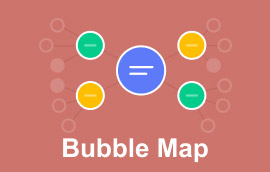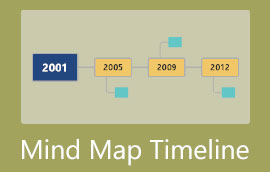What are Porter's 5 Forces? Model Explained, Example, Alternatives & More
Porter's Five Forces is a tool that many industries use to determine the root of competition. Michael Porter, a smart business professor from Harvard Business School, created it. Now, it is important to know what's influencing your industry. In that way, you can change your plan, make more profit, and excel in the competition. Here, we’ll explore this analysis, its template, example, alternatives, advantages, and disadvantages. Also, get to know the best diagram maker to create Porter's Five Forces analysis.

- Part 1. What are Porter's Five Forces
- Part 2. Porter's Five Forces Template
- Part 3. Porter's Five Forces Example
- Part 4. Advantages and Disadvantages of Porter's Five Forces
- Part 5. Alternatives to Porter's Five Forces
- Part 6. Best Tool to Make Porter's Five Forces Diagram
- Part 7. FAQs About Porter's Five Forces
Part 1. What are Porter's Five Forces
1. Competitive Rivalry
Porter's first force is about your competition. Think about how many competitors you have, who they are, and how good their service is. In a fierce rivalry, companies lower prices and use big marketing to get customers. This makes it easy for suppliers and buyers to switch. If you have few competitors and do something unique, you'll likely have a lot of control and make good money.
2. Supplier Power
Suppliers have more power when they can raise prices or lower quality. If they're the only ones who provide the service you need, they have supplier power. Even if you can change suppliers, it might cost a lot. Having more supplier choices makes it easier to switch to a cheaper option. But if there are fewer suppliers and you depend on them, they can charge you more. Thus, it can hurt your profits, especially if you're stuck in costly contracts.
3. Buyer Power
Buyer power is also one of Porter’s Five Forces that is essential. When there are more suppliers than buyers in an industry, it leads to buyer power. It only means that buyers can find it easier to switch to cheaper options or lower prices. The number of buyers, their order size, and shifting costs all matter. If you have a few smart customers, they hold more power. But if you have many customers and few competitors, their power decreases.
4. Threat of Substitution
This means how likely it is for your customers to find a different, cheaper, or better way of getting what you offer. The threat of substitution goes up when it's easy for customers to switch to something else. Also, when a new, attractive option appears in the market, they tend to choose it.
5. Threat of New Entry
It is a force that considers how easy or hard it is for new companies to enter the market. If it's easy, existing businesses face more competition, which can affect their profits. Yet, if there's not much competition and you offer something unique, you'll have a lot of control. At the same time, you’ll make good profits.
Part 2. Porter's Five Forces Template
Do you plan to make Porter’s Five Forces diagram but do not know how? Well, in this part, we’ll show you a template that you can use to create one. As mentioned above, there are 5 forces that you need to analyze. These are competitive rivalry, supplier and buyer power, substitution, and new entry threats.
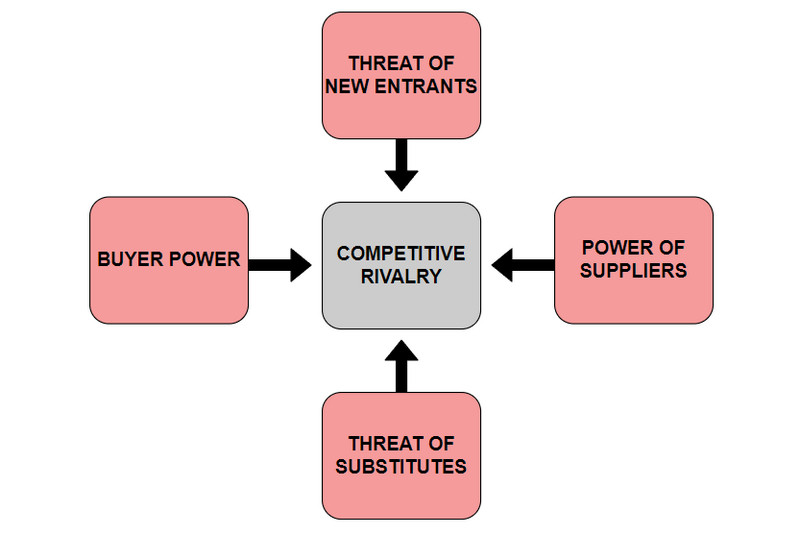
Get a detailed Porter’s Five Forces template.
Part 3. Porter's Five Forces Example
Now that you have a template, it will be easier to create a diagram for your analysis. Here, we will use Porter’s Five Forces example of Starbucks. At the same time, check out the chart example for your reference.
Starbucks is a popular American coffee shop chain. It started in 1971 in Seattle, USA, and founded by Jerry Baldwin, Zev Siegl, and Gordon Browker. Now, it is the world’s biggest coffee chain, with more than 35,000 stores. At Starbucks, you can get all kinds of drinks, from coffee to hot chocolate. You can also buy their coffee beans or instant coffee to use at home. They also sell food like pastries, sandwiches, fruits, and sweets in their coffee shops. Let’s take a look at Porter’s 5 Forces Starbucks chart below.
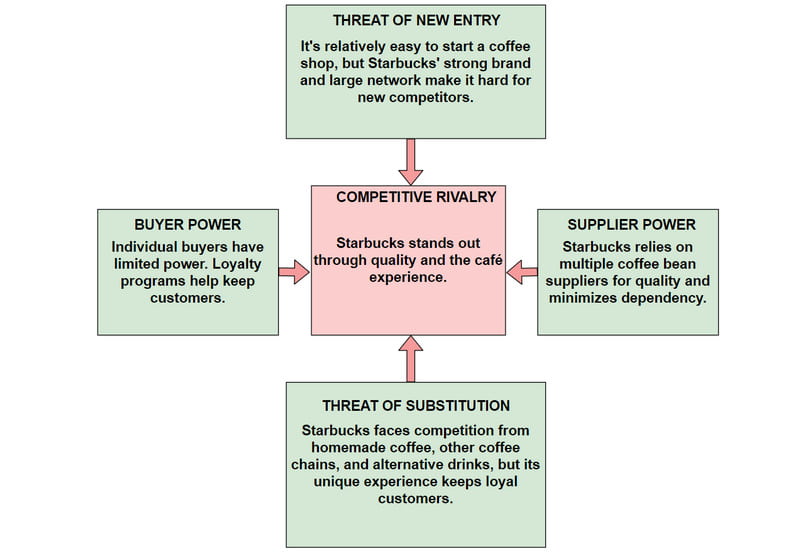
Get a detailed Starbucks Porter’s Five Forces.
Part 4. Advantages and Disadvantages of Porter's Five Forces
Advantages of Porter's Five Forces
◆ It provides a structured framework for understanding a company's competitive environment. At the same time, it helps businesses identify their strengths and weaknesses.
◆ By considering several aspects, it offers a comprehensive view of an industry. It also assists you better in decision-making.
◆ Helps businesses create strategies while taking into account the competitive forces. Thus allowing you to keep ahead of your rivals.
◆ Enables organizations to assess risks associated with their industry. It includes the threat of new entrants or substitute products.
◆ Finally, it guides resource allocation. It is through identifying areas where investment or cost-cutting may be necessary.
Disadvantages of Porter's Five Forces
◆ It may oversimplify complex market dynamics. It only considers specific factors.
◆ The model assumes that competitive forces remain stable over time. Yet, it may not always be the case in fast-paced industries.
◆ It doesn't give a clear method to measure any external factors. There’s no way to rank or decide which of the five forces is the most important for a company.
◆ Porter's Five Forces analysis works well for some industries but not for all. For instance, it doesn't help not-for-profit organizations.
◆ Assessing the power of each force is somewhat subjective. Also, it may vary from person to person, making the analysis less precise.
Part 5. Alternatives to Porter's Five Forces
1. SWOT Analysis
SWOT Analysis helps companies understand themselves better. It looks at what are the company’s strengths and weaknesses, which are things inside the company. It also considers opportunities) and threats, which are external things. By looking at these four aspects, a company can make better plans and decisions.
2. PESTEL Analysis
PESTEL Analysis helps companies see how things outside of their control affect them. It looks at six important factors: Political, Economic, Social, Technological, Environmental, and Legal. This analysis examines how these external factors impact a business. It's useful for understanding the broader environment a company operates.
3. Value Chain Analysis
Value Chain Analysis breaks down all the things a company does into two categories. These are the Primary and Support activities. Primary activities include making the product, selling it, and delivering it to customers. Support activities comprise managing employees, buying materials, and technology. This analysis helps companies identify where they can create value and reduce costs.
4. Blue Ocean Strategy
Blue Ocean Strategy is the last Porter’s Five Forces alternative you can use. It is a strategy that focuses on creating new opportunities. Some industries use it instead of competing with crowded markets (Red Oceans). It encourages creating unique products or services that don't have direct competitors. With this, they can sail in uncharted waters (Blue Oceans) and find success by being different.
Part 6. Best Tool to Make Porter's Five Forces Diagram
MindOnMap is an exceptional tool that you can use to generate Porter's Five Forces charts. It is a top choice for businesses and individuals to perform industry analysis. So, it is an online-based diagram maker that you can access on different browsers. It also offers an app version that you can download on a Windows/Mac computer. To personalize your diagram, you can use its offered shapes, lines, templates, and more. Apart from that, it lets you add text, pictures, and links. Moreover, it has an auto-saving feature that saves all the changes you’ve made. Last but not least, a collaboration feature is available. Thus allowing you to work with your peers and colleagues to share and collide more ideas. Indeed, it is a perfect tool to create Porter’s Five Forces model.
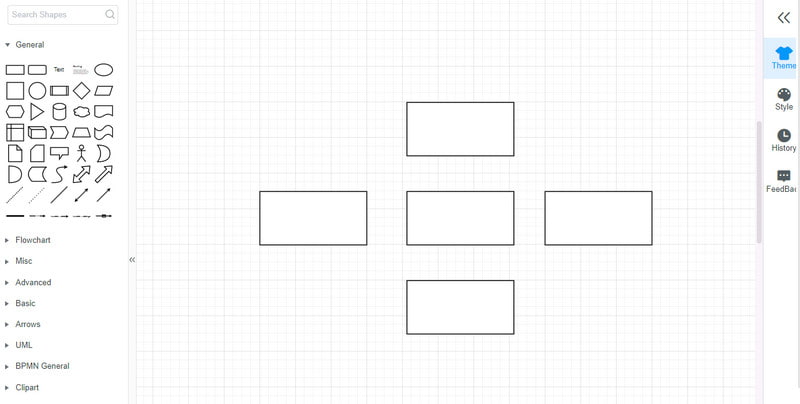
Secure Download
Secure Download
Part 7. FAQs About Porter's Five Forces
What is the purpose of Porter's Five Forces analysis?
The purpose of Porter's Five Forces is to analyze the competition of industries. Industries use it to understand the factors that influence their competitiveness and profitability.
What is Amazon Porter's Five Forces?
Amazon competes in online retail with rivals like Walmart, Flipkart, Alibaba, and eBay. But, their strong brand and investments can be a challenge for new entrants. Suppliers, especially for eCommerce and information systems, have some power. Yet, Amazon's size moderates it. Customers hold medium to high bargaining power. Amazon faces substitute threats due to low switching costs and cheaper alternatives.
What is Netflix Porter's Five Forces?
Netflix faces competition from major rivals like Amazon Video and HBO Max. While it has earned a strong reputation, new entrants might find it challenging. Netflix relies on licensed content like Friends and The Office. And it costs them tons of money for the streaming rights. It depends on monthly subscribers who can cancel anytime. If other entertainment options continue, Netflix could face substitution threats.
What are Porter's Five Forces on Apple?
Apple competes with Google, Samsung, HP, etc, which are also a strong force. Since it is a big company, the threat of new entrants is low to moderate. Apple still has tons of potential suppliers with enough supply. The power of suppliers is a weak force. Both collective and individual bargaining power are strong forces in this analysis. In Porter’s Five Forces of Apple, you’ll see a weak threat of substitute products. No product can surpass the facilities offered by Apple’s products.
Conclusion
To conclude, Porter's Five Forces is a handy and helpful guide for industries. With it, they can make better decisions and prepare for what's out there. Further, if you’re looking for an analysis diagram maker, MindOnMap is the best suit for you. With its straightforward way, it ensures that you can enjoy using it.









